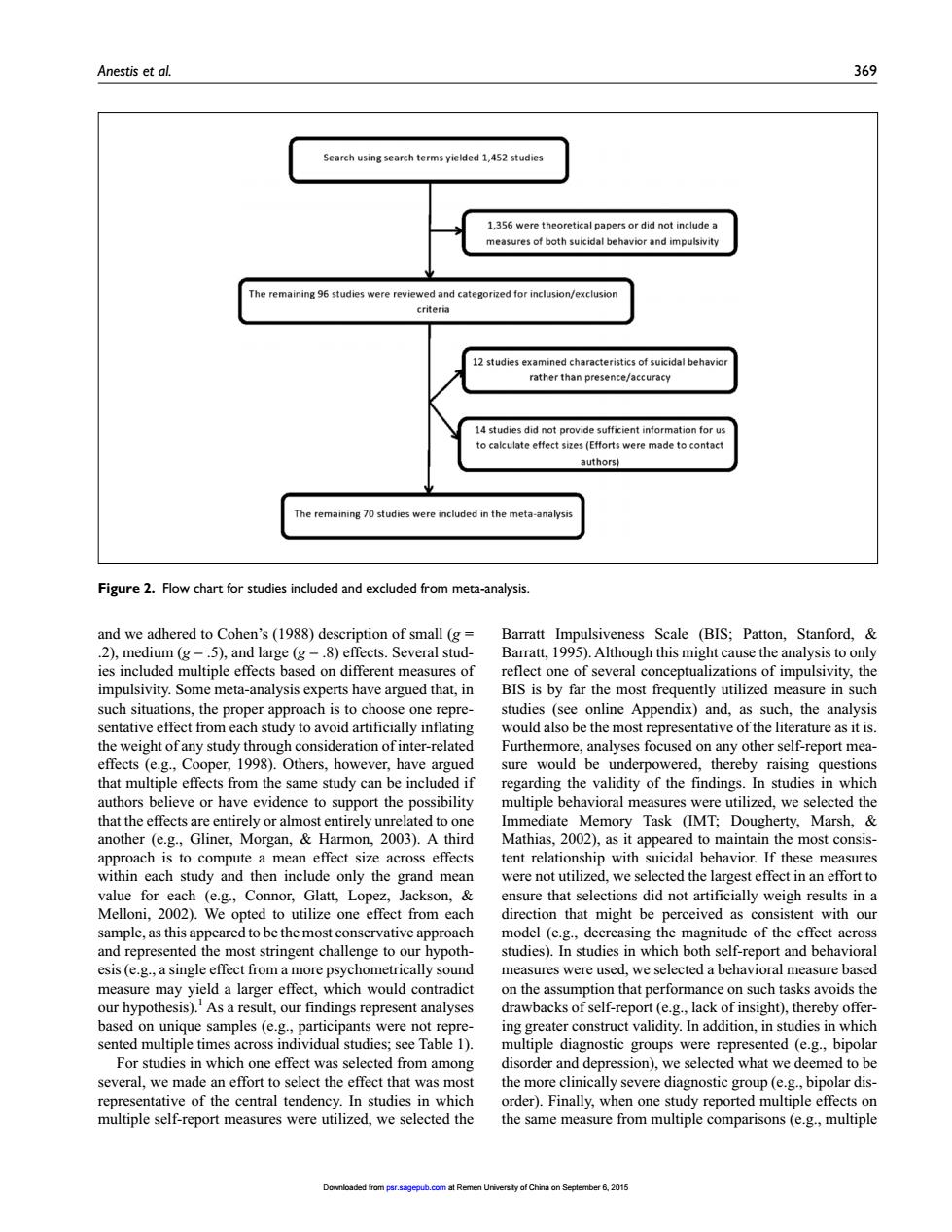正在加载图片...

Anestis et al. 369 he incuded in the meta Figure 2.Flow chart for studies included and and we eadhered to Cohen's(198)d scription of small eness (BIS;Patton,Stanford, reflect one of several con ualizations of impulsivity.the impulsivity.Some meta-analysis experts have argued that,in BIS is by far the most frequently utilized measure in such such situations,the proper approach is to choose one repre studies (see online Appendix)and,as such,the analysis be the he effects Cooper.1998)Others.however.have ar sure would be underpowered.thereby raising that multiple effects from the same study can be included if regarding the validity of the findings.In studies in which vioral measures the eeairgoramt Mathi nory la ugherty, anproach is to compute a mean effect size across effects tent relationship with suicidal behavior.If these me sures within each study and then include only the grand mean were not utilized,we selected the largest effect in an effort to Glatt,Lop hat sel ally weigh resu in in a the de( g samnle as this sing the tude e of the effect and the most stringent challenge toour hypoth studies).In studies in which both self-report and behavioral esis (e.g..a single effec from a more psychometrically sound measures were used,we selected a behavioral measure basec me a which would con on th ing greater construct validity.In addition.in studies in which sented multiple time multiple diagnostic groups were represented (e.g..bipolar For studies whi cte rom among disorder ion).we selected what we several L we ma of the ort to In multip self-repor me sures were utilized.we selected theAnestis et al. 369 and we adhered to Cohen’s (1988) description of small (g = .2), medium (g = .5), and large (g = .8) effects. Several studies included multiple effects based on different measures of impulsivity. Some meta-analysis experts have argued that, in such situations, the proper approach is to choose one representative effect from each study to avoid artificially inflating the weight of any study through consideration of inter-related effects (e.g., Cooper, 1998). Others, however, have argued that multiple effects from the same study can be included if authors believe or have evidence to support the possibility that the effects are entirely or almost entirely unrelated to one another (e.g., Gliner, Morgan, & Harmon, 2003). A third approach is to compute a mean effect size across effects within each study and then include only the grand mean value for each (e.g., Connor, Glatt, Lopez, Jackson, & Melloni, 2002). We opted to utilize one effect from each sample, as this appeared to be the most conservative approach and represented the most stringent challenge to our hypothesis (e.g., a single effect from a more psychometrically sound measure may yield a larger effect, which would contradict our hypothesis).1 As a result, our findings represent analyses based on unique samples (e.g., participants were not represented multiple times across individual studies; see Table 1). For studies in which one effect was selected from among several, we made an effort to select the effect that was most representative of the central tendency. In studies in which multiple self-report measures were utilized, we selected the Barratt Impulsiveness Scale (BIS; Patton, Stanford, & Barratt, 1995). Although this might cause the analysis to only reflect one of several conceptualizations of impulsivity, the BIS is by far the most frequently utilized measure in such studies (see online Appendix) and, as such, the analysis would also be the most representative of the literature as it is. Furthermore, analyses focused on any other self-report measure would be underpowered, thereby raising questions regarding the validity of the findings. In studies in which multiple behavioral measures were utilized, we selected the Immediate Memory Task (IMT; Dougherty, Marsh, & Mathias, 2002), as it appeared to maintain the most consistent relationship with suicidal behavior. If these measures were not utilized, we selected the largest effect in an effort to ensure that selections did not artificially weigh results in a direction that might be perceived as consistent with our model (e.g., decreasing the magnitude of the effect across studies). In studies in which both self-report and behavioral measures were used, we selected a behavioral measure based on the assumption that performance on such tasks avoids the drawbacks of self-report (e.g., lack of insight), thereby offering greater construct validity. In addition, in studies in which multiple diagnostic groups were represented (e.g., bipolar disorder and depression), we selected what we deemed to be the more clinically severe diagnostic group (e.g., bipolar disorder). Finally, when one study reported multiple effects on the same measure from multiple comparisons (e.g., multiple Figure 2. Flow chart for studies included and excluded from meta-analysis. Downloaded from psr.sagepub.com at Remen University of China on September 6, 2015